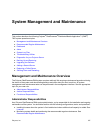
System Management and Maintenance
Polycom, Inc. 345
See also:
Dashboard
Exchange Server Integration Pane
If the Polycom RealPresence DMA system is integrated with a Microsoft Exchange server (see Microsoft
Exchange Server Integration), displays the following:
● The integration status, which can be one of the following:
Unavailable — A service status or inter-server communication problem prevented determination
of the integration status.
Error — The system was unable to establish a connection to the Exchange server. This could be
a network or Exchange server problem, or it could be a login failure.
Awaiting Active Directory — The system isn’t integrated with the Active Directory, required for
Exchange server integration.
Primary SMTP mailbox not found — The mailbox configured for the Polycom RealPresence
DMA system isn’t in the system’s Active Directory cache.
Subscription pending — The Polycom RealPresence DMA system has asked the Exchange
server to send it notifications and is waiting to receive its first notification to confirm that the
Exchange server can communicate with the system. If this status persists for more than a minute
or so, there is likely a configuration problem (such as an invalid certificate or the Exchange server
is unable to resolve the RealPresence DMA system’s FQDN).
Exchange authentication failed — The credentials for the Polycom RealPresence DMA
system’s mailbox are no longer valid (e.g., the password has expired).
OK — The Polycom RealPresence DMA system is receiving and processing Polycom
Conferencing meeting notifications from the Exchange server.
● The host name or IP address for the Exchange server as entered on the Microsoft Exchange Server
page.
● The Polycom RealPresence DMA system’s mailbox address.
● The number of Polycom Conferencing meetings today.
Click the Link button to go to the Microsoft Exchange Server page.
See also:
Dashboard
Juniper Networks SRC Integration Pane
If the Polycom RealPresence DMA system is integrated with a Juniper Networks Service Resource
Controller (see Juniper Networks SRC Integration), displays the following:
● The IP address or host name of the configured SRC server.
● The configured Server port.
● The configured Client ID.
● The configured Subscriber URI.
● The average request/response interval over the last ten interactions with the configured SRC server.
Click the Link button to go to the Juniper Networks SRC page.


















